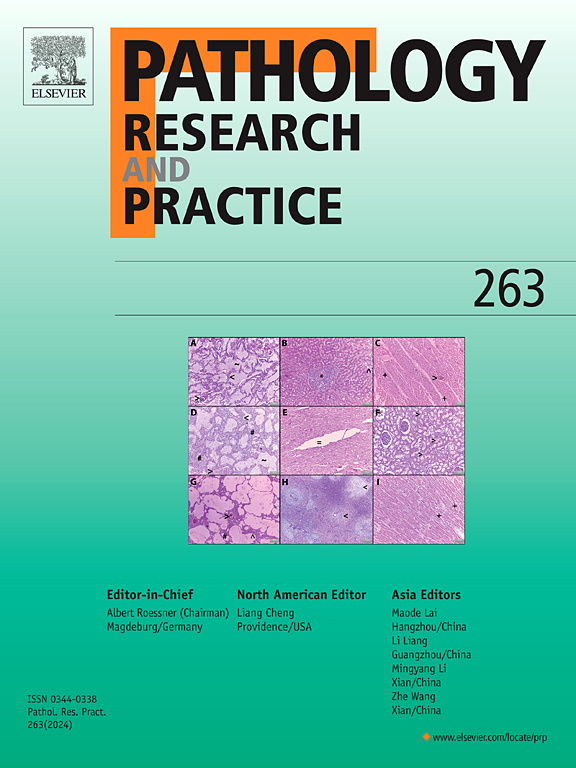The interplay of NAD+, hyperuricemia, and renal damage: A scientific review
IF 3.2
4区 医学
Q2 PATHOLOGY
引用次数: 0
Abstract
Identifying potential mechanisms by which hyperuricemia might cause kidney diseases is important, as it may help identify new therapies. Nicotinamide adenine dinucleotide (NAD+) is a coenzyme involved in hundreds of metabolic reactions, including bioenergetics, DNA repair, and gene expression. Hyperuricemia (HU) is a common metabolic disorder associated with the development of chronic kidney disease (CKD), beyond its well-established links to gout and kidney stones. Here, we review the complex relationship between NAD+ levels, HU, and renal damage. Uric acid (UA) crystal deposition induces a local inflammatory response linked to Toll-like receptor and inflammasome activation, while soluble UA drives mitochondrial and endothelial dysfunction, activation of the renin-angiotensin system, inflammation, and epithelial and endothelial-to-mesenchymal transition. Here we discuss how oxidative stress, mitochondrial dysfunction, and inflammation from HU can indirectly deplete intracellular NAD+ by increasing the activity of NAD+-consuming enzymes. Given NAD+´s critical role in kidney health, therapeutically increasing NAD+ levels through precursor supplementation (e.g., nicotinamide, nicotinamide riboside, nicotinamide mononucleotide) or inhibiting NAD+ consuming enzymes shows promise for preventing or treating HU-associated kidney damage. We recommend clinical trials to determine if increasing NAD+ levels can improve the management of HU-induced kidney disease.
NAD+、高尿酸血症和肾损害的相互作用:一项科学综述。
确定高尿酸血症可能导致肾脏疾病的潜在机制是重要的,因为它可能有助于确定新的治疗方法。烟酰胺腺嘌呤二核苷酸(NAD+)是一种参与数百种代谢反应的辅酶,包括生物能量学、DNA修复和基因表达。高尿酸血症(HU)是一种常见的代谢性疾病,与慢性肾脏疾病(CKD)的发展有关,它与痛风和肾结石之间的联系已经确立。在这里,我们回顾了NAD+水平、HU和肾损害之间的复杂关系。尿酸(UA)晶体沉积诱导与toll样受体和炎性体激活相关的局部炎症反应,而可溶性UA驱动线粒体和内皮功能障碍、肾素-血管紧张素系统激活、炎症以及上皮和内皮向间质转化。在这里,我们讨论氧化应激、线粒体功能障碍和炎症如何通过增加NAD+消耗酶的活性间接消耗细胞内NAD+。鉴于NAD+在肾脏健康中的关键作用,通过补充前体(如烟酰胺、烟酰胺核苷、烟酰胺单核苷酸)或抑制NAD+消耗酶来治疗性地增加NAD+水平,有望预防或治疗尿毒症相关的肾损害。我们建议进行临床试验,以确定NAD+水平的增加是否可以改善尿毒杆菌引起的肾脏疾病的管理。
本文章由计算机程序翻译,如有差异,请以英文原文为准。
求助全文
约1分钟内获得全文
求助全文
来源期刊
CiteScore
5.00
自引率
3.60%
发文量
405
审稿时长
24 days
期刊介绍:
Pathology, Research and Practice provides accessible coverage of the most recent developments across the entire field of pathology: Reviews focus on recent progress in pathology, while Comments look at interesting current problems and at hypotheses for future developments in pathology. Original Papers present novel findings on all aspects of general, anatomic and molecular pathology. Rapid Communications inform readers on preliminary findings that may be relevant for further studies and need to be communicated quickly. Teaching Cases look at new aspects or special diagnostic problems of diseases and at case reports relevant for the pathologist''s practice.

 求助内容:
求助内容: 应助结果提醒方式:
应助结果提醒方式:


